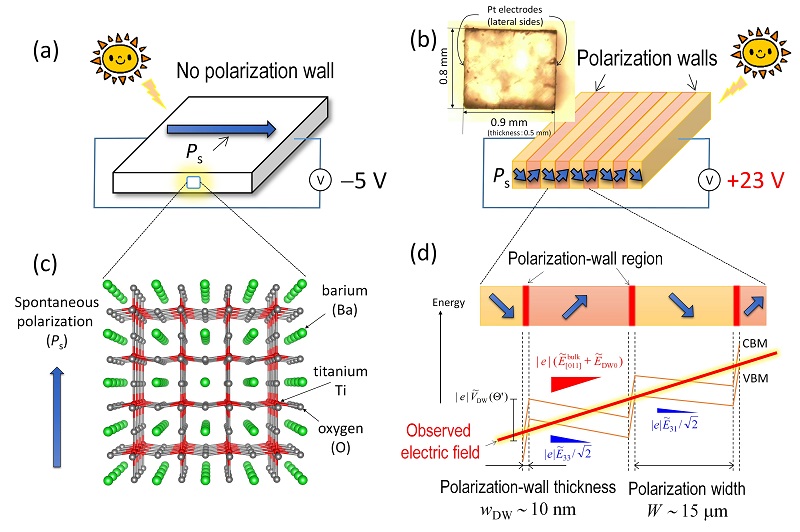Development of ferroelectric devices delivering giant voltage under visible light Toward giant-voltage generation beyond 1000 volts


Ferroelectric polarization domain walls deliver giant voltage under visible light
Ferroelectrics with no walls (a) generate 5 volts while those with polarization walls (b) deliver a high voltage of +23 volts. The polarization walls originating from spontaneous polarization in ferroelectrics (c) are demonstrated to have a photovoltaic effect 8000 times as high as the inside of a crystal (d).
© 2015 Yuji Noguchi.
University of Tokyo researchers have succeeded in developing ferroelectric devices delivering a high voltage of 23 volts under visible light. This result is expected to contribute to clean energy generation from sunlight.
Semiconductor materials capable of converting light into electricity are utilized in photovoltaic cells. However, the voltage that can be generated by present semiconductor-based devices is of the order of a few volts at most. Recently it has been reported that high voltages can be generated in ferroelectric thin films, which has stimulated active research and development of photoelectric conversion devices using ferroelectric materials. However, multiple challenges remained, such as difficulty in establishing device design and still unknown principles behind power generation.
The research group of Associate Professor Yuji Noguchi, then-Project Researcher Ryotaro Inoue and Professor Masaru Miyayama at the Graduate School of Engineering demonstrated the generation of a high voltage from visible light using a crystal of the ferroelectric material barium titanate using a polarization wall with a few nanometers thickness between domains. In addition, the research group showed that by controlling the structure of the polarization wall is possible in principle to obtain huge voltages of over 1000 volts.
“This results obtained in this study may also be applicable to other polar materials such as zinc oxides and gallium nitride,” says Associate Professor Noguchi. He continues, “The combination of this research with conventional semiconductor photovoltaic systems may lead to increases in photoelectric conversion efficiency.”
Paper
, "Giant photovoltaic effect of ferroelectric domain walls in perovskite single crystals", Scientific Reports Online Edition: 2015/10/07 (Japan time), doi: 10.1038/srep14741.
Article link (Publication)
Links
Graduate School of Engineering
Department of Applied Chemistry, Graduate School of Engineering
Miyama Laboratory, Department of Applied Chemistry, Graduate School of Engineering (Japanese)






